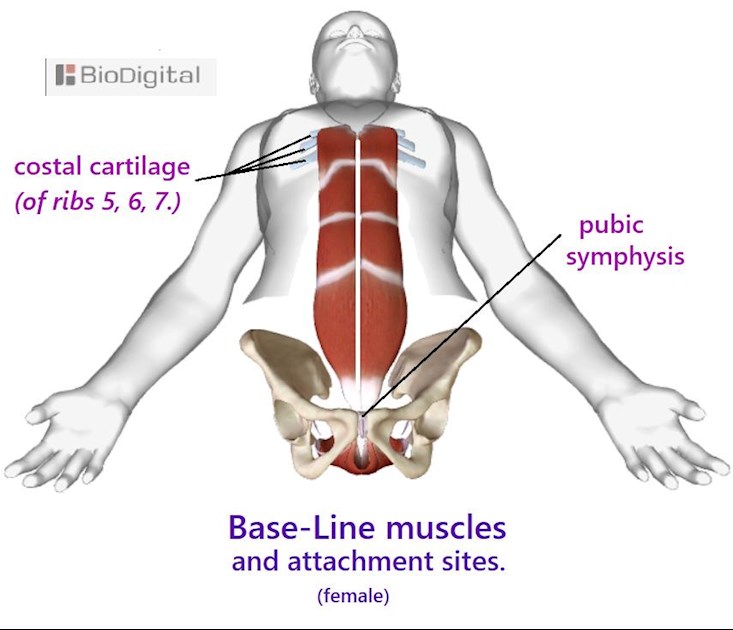The following theory is based on my recovery from nearly 20 years of depression and a life-time of physical pain:
Base-Line Theory An Explanation for the Symptoms of Fibromyalgia.
The current diagnosis of fibromyalgia really means:
"We don't know why you have all these pains, but a lot of other people have them too".
Fibromyalgia is often described as 'poorly understood', but idiopathic {the cause is not known} would be the correct term - until now.
The label of fibromyalgia is very apt. Based on my recovery, I believe the textbook symptoms of 'fibro' are caused by an issue with our muscles and the web of fibrous connective tissue that runs throughout the body.
The symptoms of fibromyalgia are very real, and expletively painful at times.
Muscle pain occurs when the main muscles of movement are not adequately utilised and the body is not aligned and balanced around our Base-Line.
Other areas of muscle try to compensate but they become stressed, sore, and fatigued.
Adaptations of the connective tissue system (in response to injury and as it tries to provide support to an unbalanced body) result in restrictions within the tissues that reduce our range of movement - literally stiffening us over time.
These changes in our connective tissue apply tensions that radiate throughout the whole body, and the sensory information generated by the restrictions the source of many pains and weird sensations.
People who use their body correctly, balanced around their Base-Line, are able to shake off old injuries and return to a good posture, but those of us that don't end up carrying the trauma around. The body becomes increasingly tense, unbalanced and misaligned over time.
I believe the pain sets in early when the body becomes imbalanced and, if you were pain free, then it's likely the pains are considered significant enough to seek medical advice leading to an early diagnosis of fibromyalgia.
Cumulative damage over the years can result in layers upon layers of restrictions. Chains of tension zig-zagging from left to right, inside to out, front to back, through the whole of the body with a vastly reduced range of movement.
Chronic pain affects our mental health. The fibro fog, depression.
Base-Line Theory of Human Health and Movement: The Five Main Muscles of Movement and Conscious Proprioception.
The key to better health.
By Leigh S. Blyth BVM&S
Our main muscles of movement are the 5 paired (left and right side) muscles that are of key importance to our physical and mental well-being.
Our pelvic floor (actually a group of muscles), rectus abdominis, gluteus maximus, rectus femoris and trapezius muscles.
These 5 main muscles of movement (when fully utilised and the body is free of restrictions) provide:
The physical support required for a full range of natural movement and a balanced body.
Sensory feedback for our sense of conscious proprioception, connecting body and mind.
Conscious Proprioception:
"The ability to sense the position of your body in space and being aware of where you should be able to move."
Central to the main muscles of movement are our Base-Line muscles: Pelvic floor 'Base' and rectus abdominis 'Line'.
All movement should originate from, and be supported by, the Base-Line muscles. Our core pillar of strength.
The gluteus maximus and rectus femoris muscles of each leg work in tandem to connect our legs to Base-Line support.
The trapezius muscles should be free to fully extend in all directions, supporting the head and arms through a full range of movement. With Base-Line support in place, movement of the upper body should begin from the lower (inferior) trapezius.
The position of the rest of the body should be considered relative to our Base-Line, with the linea alba (between the rectus abdominis) on the body's median plane serving as the primary reference for body alignment.
The supraspinous ligament and nuchal ligament (ligamentum nuchae), also on the median plane and closely associated with the trapezius muscles, are our secondary guides for alignment.
The anatomical structures on the median plane consist of strips of connective tissue that we have no direct control over, but by working with the associated main muscles of movement we can feel the relative positions of these structures, developing our conscious proprioception skills to work through tensions and regain our natural range of movement and sense of well-being.
I believe that many of the chronic pain symptoms and syndromes currently classified as idiopathic are due to the adaptations of the body when the main muscles of movement are not adequately functioning. Stresses on other muscles and restrictions that form in the connective tissue system can cause varied and widespread painful symptoms.
Chronic pain affects our mental well-being, and was the root cause of my long-term depression and mental health issues.
